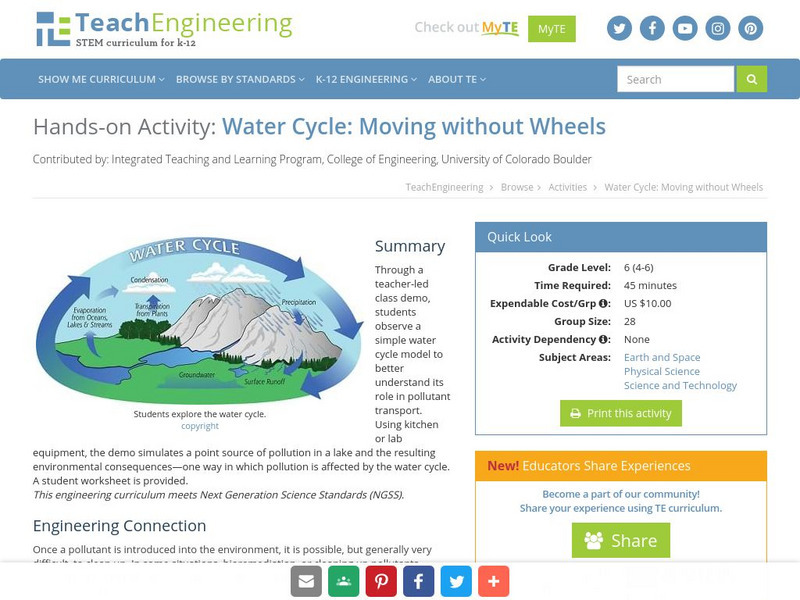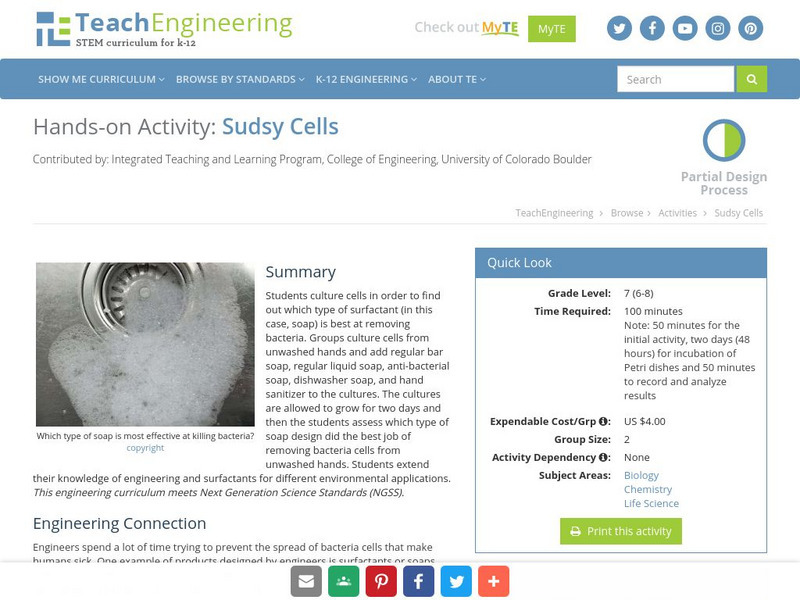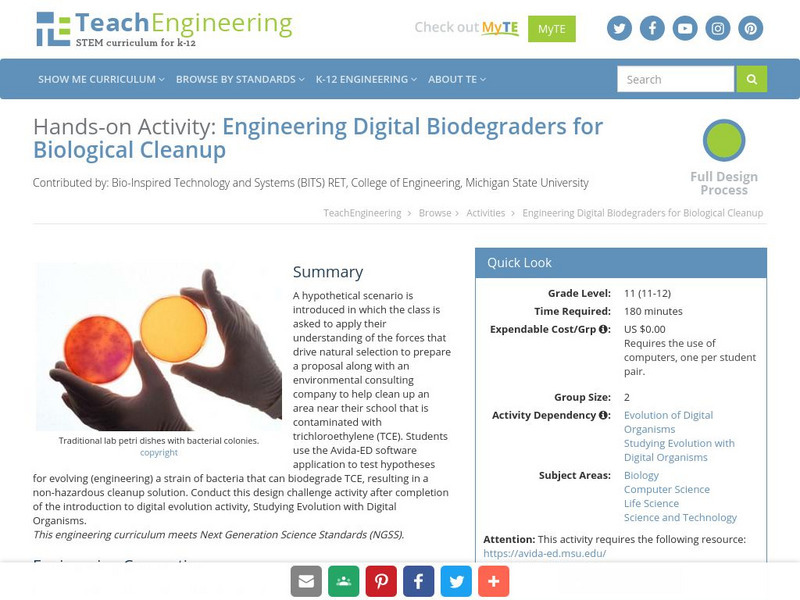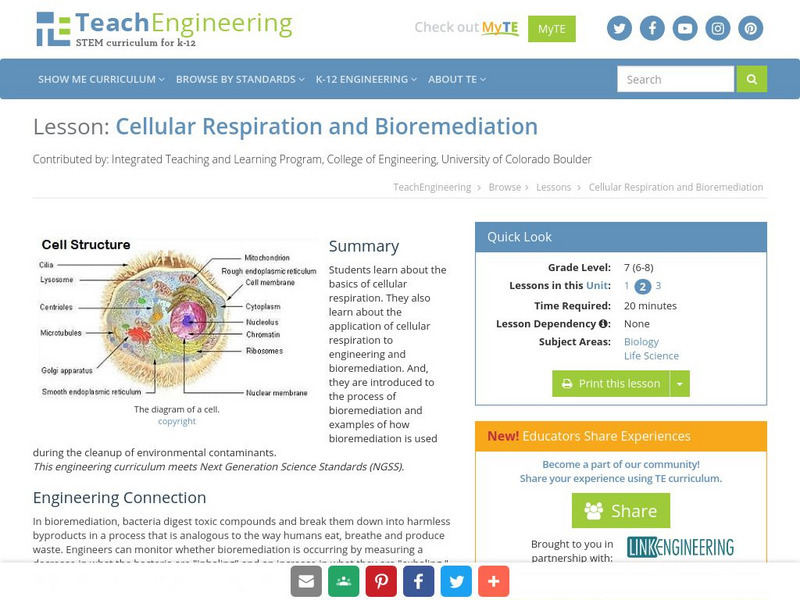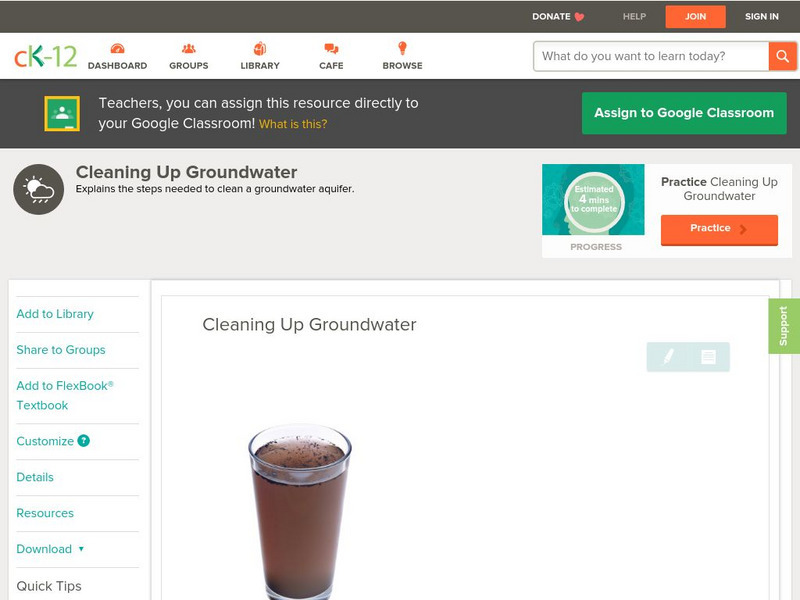US Geological Survey
Us Geological Survey: Bioremediation: Nature's Way to a Cleaner Environment[pdf]
Excellent information provided by the U.S. Geological Survey.
TeachEngineering
Teach Engineering: Moving Without Wheels
In a class demonstration, students observe a simple water cycle model to better understand its role in pollutant transport. This activity shows one way in which pollution is affected by the water cycle; it simulates a point source of...
TeachEngineering
Teach Engineering: Sudsy Cells
Students culture cells in order to find out which type of surfactant (in this case, soap) is best at removing bacteria. Groups culture cells from unwashed hands and add regular bar soap, regular liquid soap, anti-bacterial soap,...
TeachEngineering
Teach Engineering: Breathing Cells
Students use a simple pH indicator to measure how much CO2 is produced during respiration, at rest and after exercising. They begin by comparing some common household solutions in order to determine the color change of the indicator....
TeachEngineering
Teach Engineering: Sugar Spill!
In this activity, students act as environmental engineers involved with the clean up of a toxic spill. Using bioremediation as the process, students select which bacteria they will use to eat up the pollutant spilled. Students learn how...
TeachEngineering
Teach Engineering: Evolving Tce Biodegraders
A hypothetical scenario is introduced in which the class is asked to apply their understanding of the forces that drive natural selection to prepare a proposal along with an environmental consulting company to help clean up an area near...
TeachEngineering
Teach Engineering: Cells
In this unit, students look at the components of cells and their functions and discover the controversy behind stem cell research. The first lesson focuses on the difference between prokaryotic and eukaryotic cells. In the second lesson,...
TeachEngineering
Teach Engineering: Life Science
This unit covers the processes of photosynthesis, extinction, biomimicry and bioremediation. In the first lesson on photosynthesis, students learn how engineers use the natural process of photosynthesis as an exemplary model of a complex...
TeachEngineering
Teach Engineering: Cellular Respiration and Bioremediation
Students learn about the basics of cellular respiration. They also learn about the application of cellular respiration to engineering and bioremediation. And, they are introduced to the process of bioremediation and examples of how...
TeachEngineering
Teach Engineering: Clean It Up!
Students learn about a special branch of engineering called bioremediation, which is the use of living organisms to aid in the clean-up of pollutant spills. Students learn all about bioremediation and see examples of its importance. In...
Lawrence Berkeley National Laboratory
Berkeley Lab: Did You Ever Wonder? Best Bugs for Cleaning Up Toxic Waste?
Students explore bioremediation. The article discusses how to use infrared synchrotron light to study the biological response of living microbes to contaminants. The resource consists of pictures, quotes, and links to additional resources.
Encyclopedia of Earth
Encyclopedia of Earth: Bioremediation
Explains what bioremediation is, how it works, whether it is a safe process, the length of time it takes, and reasons for doing it. (Updated: September 23, 2011)
TeachEngineering
Teach Engineering: Cleaning Up With Decomposers
Students investigate decomposers and the role of decomposers in maintaining the flow of nutrients in an environment. Students also learn how engineers use decomposers to help clean up wastes in a process known as bioremediation. This...
CK-12 Foundation
Ck 12: Earth Science: Cleaning Up Groundwater
[Free Registration/Login may be required to access all resource tools.] How polluted groundwater is cleaned up.
CK-12 Foundation
Ck 12: Earth Science: Cleaning Up Groundwater
[Free Registration/Login may be required to access all resource tools.] How polluted groundwater is cleaned up.
CK-12 Foundation
Ck 12: Earth Science: Cleaning Up Groundwater Study Guide
This comprehensive study guide covers the main terms and concepts needed for an earth science unit on cleaning up groundwater. Review questions are included at the bottom of the study guide.
Science Daily
Science Daily: Caution Required for Gulf Oil Spill Clean Up
A bioremediation expert cautions against the concentration of detergents and other chemicals used to clean up oil spills. The clean-up can be a nightmare of its own when toxic agents are used.
Other
Australian Maritime Safety Authority:experiment Demonstrating Oil Bioremediation
An experiment to investigate how bacteria causes oil to degrade over time, a process that helps the ocean slowly recover from an oil spill.
Sophia Learning
Sophia: Genetic Engineering Applications
This lesson will examine the pros and cons of various applications of genetic engineering and biotechnology.


![Us Geological Survey: Bioremediation: Nature's Way to a Cleaner Environment[pdf] Handout Us Geological Survey: Bioremediation: Nature's Way to a Cleaner Environment[pdf] Handout](https://d15y2dacu3jp90.cloudfront.net/images/attachment_defaults/resource/large/FPO-knovation.png)
